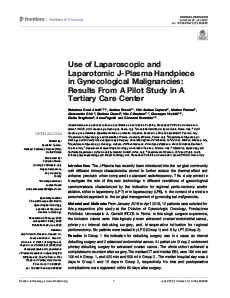Use of Laparoscopic and Laparotomic J-Plasma® Handpiece in Gynecological Malignancies: Results From A Pilot Study in A Tertiary Care Center
ITEM TYPE:
Journal Article
AUTHORS:
Salvatore Gueli Alletti, Andrea Rosati, Vito Andrea Capozzi, Matteo Pavone, Alessandro Gioè, Stefano Cianci, Vito Chiantera, Giuseppe Vizzielli, Giulia Scaglione, Anna Fagotti, and Giovanni Scambia
ABSTRACT:
Introduction: The J-Plasma has recently been introduced into the surgical community with different intrinsic characteristics aimed to further reduce the thermal effect and enhance precision when compared to standard radiofrequency. This study aimed to investigate the role of this new technology in different conditions of gynecological carcinomatosis characterized by the indication for regional peritonectomy and/or ablation, either in laparotomy (LPT) or in laparoscopy (LPS), in the context of a modern personalized approach to the surgical management of gynecological malignancies.
Material and Methods: From January 2019 to April 2019, 12 patients were selected for this prospective pilot study at the Division of Gynecologic Oncology, Fondazione Policlinico Universitario A. Gemelli IRCCS in Rome. In this single surgeon experience, the inclusion criteria were: histologically proven advanced ovarian/endometrial cancer, primary or interval debulking surgery, and intraoperative indication for regional peritonectomy. Six patients were treated by LPS (Group 1) and 6 by LPT (Group 2).
Results: In Group 1 the indication for debulking surgery was in 4 cases an interval debulking surgery and 2 advanced endometrial cancer. All patients in Group 2 underwent primary debulking surgery for advanced ovarian cancer. The whole cohort achieved a complete tumor excision after surgery. The median OT and median EBL were 195 min and 100 ml in Group 1, and 420 min and 500 ml in Group 2. The median hospital stay was 4 days in Group 1 and 13 days in Group 2, respectively. No intra and postoperative complications were registered within 60 days after surgery.
Conclusions: J-Plasma allows to approach delicate maneuvers on viscera, mesentery, and blood vessels with a high degree of safety and precision thanks to its limited vertical and lateral thermal spread, favoring the surgeon to push ever higher the cytoreduction/morbidity tradeoff. The use of J-Plasma in cytoreductive surgery could also increase the range of possible minimally invasive procedures, narrowing the technical distance with the open technique and thus contributing to designing a personalized surgical strategy for each patient in different scenarios of peritoneal carcinomatosis.
APYX® MEDICAL DISCLOSURES:
FINANCIAL & CONTENT DISCLOSURE
The authors declared no potential conflicts of interest with respect to the research, authorship, and publication of this article. No funding was received for this article. The opinions contained herein are those of the authors and do not necessarily represent the official position or policies of Apyx Medical, Inc.
MANUFACTURING DISCLOSURE
Apyx Medical (previously Bovie® Medical) manufactures and owns the J-Plasma technology discussed in this article.
INDICATIONS FOR USE & INTENDED USE DISCLOSURES
- The Renuvion® Precise, Precise Open, and J-Plasma Handpieces are intended to be used with compatible electrosurgical generators for the delivery of radiofrequency energy and/or helium plasma for cutting, coagulation, and ablation of soft tissue during open surgical procedures.
- Apyx Medical wants to present to you with current scientific discourse.
RISKS
- Risk associated with the use of the device may include: Helium embolism into the surgical site due to inadvertent introduction into the venous or arterial blood supply system, unintended burns (deep or superficial), pneumothorax, temporary or permanent nerve injury, ischemia, fibrosis, infection, pain, discomfort, gas buildup resulting in temporary and transient crepitus or pain, bleeding, hematoma, seroma, subcutaneous induration, pigmentation changes, increased healing time, and/or unsatisfactory scarring. There may be additional risks associated with the use of other devices along with Renuvion/J-Plasma and there may be an increased risk for patients who have undergone prior surgical or aesthetic procedures in the treatment area.
As with any procedure, individual results may vary. As with all energy devices there are inherent risks associated with its use, refer to the IFU for further information.



